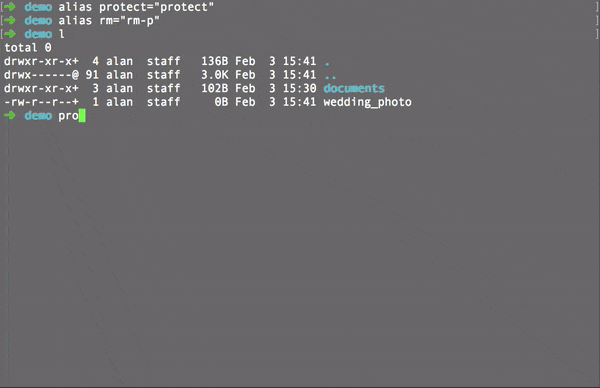A safe alternative for rm with minimum difference.
rm-protection is a safe alternative for removing file. It works
exactly the same as rm (in fact it passes arguments to rm). The only
difference is that it refuses to procceed if a .*.rm-protection file is
found and you failed to answer a question.
pip install rm-protection
- Install from PyPi and make an alias for
rm-p. - Protect your files using
protect. If you want to protect everything inside,protect -R. - Happy rm-ing!
It consists of two utilities: rm-p and protect. The latter one
is to help you protect files.
For example, you have a file called important_file and it is
protected by .important_file.rm-protection. rm-p will
recognise that important_file is protected and prompt to ask you a
question stored in .important_file.rm-protection. rm-p will only
proceed if you get the answer right.
See it in action:
It will also prevent you from deleting a directory with protected
file(s) inside.
- Python 2 or 3
- Linux, unix and macOS
find
- Currently does not support protecting files whose name starts with "-".
| Methods | Can be uesd as "rm"? | Protect Specific Files | Flexibi lity | Additional Files |
|---|---|---|---|---|
| trash-cli | Yes | Somehow | High | Centralised Config |
| rm -i | Yes | No or Somehow | High | |
| safe-rm | Yes | Yes | Low | Centralised Config |
| rm-protection | Yes | Yes | High | One for each |
rm-protection aims at providing maximum protection and flexibility
while making minimum impact on daily operation.
rm -i can be very annoying, trash-cli is a bit complex (imagine
you have a habit of emptying the trash without a second thought, or
imagine you are trying to free up spaces on a budget vm). Safe-rm is
inconvenient when you really need to delete something (you have to edit
the configuration file).
Instead, rm-protection asks you a question set by you. You are fully
covered when removing files (you won't accidentally empty the trash with
trash-cli or | yes with rm -i), and you can quickly remove
files (without editing any configuration files).
Pull requests and issues are all welcome! Or tell others about this, so
you can even protect the files you send to others!


